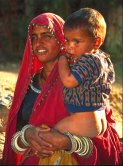Status and Role
|
|
|
|
Commonly expected |
|
In all of the many social groups that we as
individuals belong to, we have a status and a role to fulfill.
Status
is our relative social position within a group, while a
role is the
part our society expects us to play in a given status. For example, a
man may have the status of father in his family. Because of this status,
he is expected to fulfill a role for his children that in most societies
requires him to nurture, educate, guide, and protect them. Of course,
mothers usually have complementary roles.
Social group membership gives us a set of statuses and role tags that allow people to know what to expect from each other--they make us more predictable. However, it is common for people to have multiple overlapping statuses and roles. This potentially makes social encounters more complex. A woman who is a mother for some children may be an aunt or grandmother for others. At the same time, she may be a wife for one or more men, and she very likely is a daughter and granddaughter of several other people. For each of these various kinship statuses, she is expected to play a somewhat different role and to be able to switch between them instantaneously. For instance, if she is having a conversation with her mother and young daughter, she is likely to politely defer to the former but will be knowledgeable and "in-control" with the other. These role related behaviors change as rapidly as she turns her head to face one or the other. However, her unique personal relationships might lead her to think and act differently than what would be culturally expected. In other words, social group membership gives us a set of role tags that allow people to know what to expect from each other, but they are not always straight jackets for behavior.
 |
Three generations of women in a family, each playing several different roles in their casual interaction. |
Acquiring Statuses
The way in which people get our statuses can vary significantly in detail from culture to culture. In all societies, however, they are either achieved or ascribed. Achieved statuses are ones that are acquired by doing something. For instance, someone becomes a criminal by committing a crime. A soldier earns the status of a good warrior by achievements in battle and by being brave. A woman becomes a mother by having a baby. She also can acquire the status of widow by the death of her husband. In contrast, ascribed statuses are the result of being born into a particular family or being born male or female. Being a prince by birth or being the first of four children in a family are ascribed statuses. We do not make a decision to choose them--they are not voluntary statuses. We do not pick the family we are born into nor do we usually select our own gender.
 |
|
Bill Clinton
rose from relative |
Both achieved and ascribed statuses exist in all societies. However, some cultures choose to emphasize the importance of one or the other. In North America today, achieved statuses outside of the family are reinforced while ascribed ones are generally rejected. Children are encouraged from an early age to be independent and self-reliant. They are told to better themselves in life. This can be seen in the admiration of "self-made people" and in the somewhat negative image in the mass media of people who are rich only because they inherited it. This strong cultural bias has led to the enactment of anti-nepotism laws for government jobs. These make it a crime to hire and promote people because they are your relatives. In addition, the North American emphasis on achieved status has led to an acceptance and encouragement of social class mobility and a rejection of gender and ethnicity based restrictions. Children are taught in school from an early age that, despite the fact that they may be from a poor family, male or female, they should aspire to get a good education, better themselves and their family economically, and even become a leader in society.
In India, ascribed, rather than achieved, social
status has been strongly reinforced for more than 3,000 years and permeates
most areas of life even today. As a result, social mobility has been
very difficult to achieve until recent generations. Even now, it is limited for those at the bottom of society. At the heart of the
Indian ascription system are castes
![]() (or varnas
(or varnas
![]() ). These are carefully ranked, rigidly
hereditary social divisions of society.
). These are carefully ranked, rigidly
hereditary social divisions of society.
|
|
|
|
Lower caste woman |
|
Each of the Indian castes have sub-castes, or jatis
![]() ,
that in turn are ranked relative to each other. The whole system is
reinforced by the Hindu religion and historical traditions. The one sixth of
all Indians who are members of the "scheduled castes" are essentially so low in
status as to be outside of the formal caste system. They are the
poorest people, and they mostly do the "unclean" ritually polluting jobs of sweeping streets,
cleaning toilets, tanning leather, etc. Members of the other castes are not as restricted
in their occupations and aspirations today. However, caste identity
largely determines who one can marry in India and it prevents socializing
across caste lines.
,
that in turn are ranked relative to each other. The whole system is
reinforced by the Hindu religion and historical traditions. The one sixth of
all Indians who are members of the "scheduled castes" are essentially so low in
status as to be outside of the formal caste system. They are the
poorest people, and they mostly do the "unclean" ritually polluting jobs of sweeping streets,
cleaning toilets, tanning leather, etc. Members of the other castes are not as restricted
in their occupations and aspirations today. However, caste identity
largely determines who one can marry in India and it prevents socializing
across caste lines.
Underlying and constantly reinforcing the Indian caste system is the Hindu religion and its concept of ritual pollution. People in the higher castes must take great care not to be polluted by contact with members of the lower castes and especially the "untouchables." Being polluted puts one out of one's caste and requires ritual cleansing. As a result, Indian restaurants usually have chefs who are from the Brahman caste. Since they are at the top of this ascribed status system, they cannot pollute any customers, regardless of their caste. Likewise, a Brahman doctor would be more acceptable to all.
The Indian national government has attempted to encourage achieved status by outlawing many of the traditional aspects of the caste system. They also have instituted affirmative action programs to increase the number of lower caste and "untouchable" students in universities and government. This social engineering has faced considerable resentment and resistance from members of the higher castes. However, the Indian government continues to encourage this change with the hope that social mobility will ultimately make the caste system less relevant to public life.
Castes are not limited to India. They may be found in one form or another in most nations today. In Europe, the royal families traditionally were a separate caste from the peasant farmers, tradesmen, and other classes. Only rarely were "commoners" allowed to become members of the royalty. In North America, one's race or ethnicity is often a caste identity. Most black, white, or other Americans do not have the option of waking up tomorrow and deciding that they will be a different race. Society generally will not allow them to do it. While race is greatly a socially and culturally constructed reality rather than a biological one, it is still a reality just the same in North America and in much of the rest of the world as well.
This page was last updated on
Tuesday, June 27, 2006.
Copyright © 2003-2006 by Dennis
O'Neil.
All rights reserved.
Illustration credits

